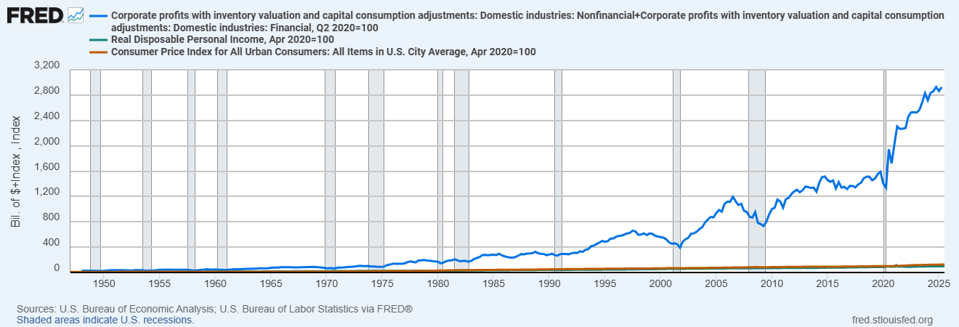The Bureau of Economic Analysis released estimates on gross domestic product corporate profits for the second quarter of 2025. Things look as though they’re improving; however, it is more tenuous than the surface seems. And personal income again trails behind.
Q2 2025 GDP
The BEA’s second estimate of real GDP performance (after taking account of inflation) in the second quarter saw an annualized rate of 3.3% after the first quarter’s -0.5% descent. That may sound like incredible improvement, but much of GDP’s recent history is more a tale of tariffs.
The GDP change in the first quarter — -0.3% in the first estimate that would become the -0.5% — was the result of several factors. A big one was a surge in imports. Under the definition of GDP, exports are added, and imports are subtracted from the total because the former are considered a product of the national economy, and the latter are expenditures that aren’t domestic products.
The initial estimate of annualized GDP growth for Q2 was 3.0%. The BEA said that the upward change primarily reflected upward revisions to investment and consumer spending that were partly offset by a downward revision to government spending and upward revisions to imports.
Tariffs and the reactions of industries and markets continue to have major effects on GDP. With such obvious volatility in play, however, trying to lay odds on the immediate future seems only wishful thinking. And what will happen going forward is even harder to predict, given that an appeals court found President Trump’s tariffs illegal.
Gross Domestic Income And Corporate Profits
GDI is another measure of the economy, the total earned by everyone in a country, including wages, profits, rents, royalties, investment income, etc. In theory, it’s supposed to equal GDP, but rarely does because it uses different data sources that are narrower and also less timely.
Rather than 3.3%, to equal GDP, it came in at 4.8% a big difference and not something easily understood, especially given the wildly divergent incomes in what has become a bifurcated economy, as famous financial analyst Meredith Whitney told MarketWatch.
This is shown by the difference between disposable personal income growth and that of corporate profits when indexed for comparison. Below is a graph created through the FRED data site of the Federal Reserve Bank of St. Louis.
The blue line is a combination of corporate profits of both financial and non-financial non-farm corporations. The green line is real disposable personal income, which means income after all taxes. The red line is the Consumer Price Index as a measure of inflation. All the data is quarterly, and figures are indexed to the end of the 2020 recession.
There’s an enormous imbalance in the country’s economics, tariffs or not. It’s not something that a change in trade will fix. The effect of tariffs is starting to come through economic indicators. How much the effects will affect the consumers whose spending makes up 69% of GDP is impossible to know yet. Would a full legal stop of Trump’s tariffs reverse any damages? Again, no way to know. And none of that will help with the spiraling debt that will eventually undermine the country.

